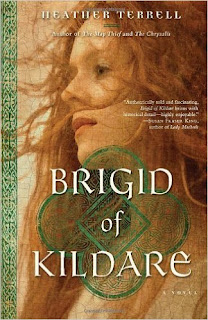Another one bites the dust.
9) A book recommended by another person or organization (like your library!) - in my case a Goodreads list
Brigid of Kildare by Heather Terrell
This book started out being a bit confusing. Normally I really enjoy books that are told from multiple points of view, but it took me a couple chapters to finally grasp that the stories were being told at different paces, starting at different points in time, especially that of the Roman monk Decius and Gaelic Brigid. The Decius POV chapters take place over the span of roughly a year and a half, from 470 A.D. to 471 A.D. The "Brigid: A Life" POV chapters start 456 A.D. and go to 472 A.D. And the Alexandra Patterson POV chapters take place over the course of roughly 1-2 weeks in the "present day."
The basic frame of the story is that appraiser, Alexandra "Alex" Patterson is asked to come to Kildare to appraise several artifacts thought to date back to the time of Brigid of Kildare and the nun who is the current "keeper" of these artifacts wants to sell them so they can use the money to spread the word about the "true" Brigid and the "true" Mary, Mother of God. In so doing, she discovers a hidden book, that she thinks might predate the Book of Kells and would therefore contain the earliest known iconography of the Virgin Mary with the baby Jesus that doesn't involve a general nativity scene. She also discovers two books in the abbey archives that date to the same time period, one a book of letters, and one a history of the abbey and Brigid.
The Decius POV chapters are all in the form of letters to his brother and you can surmise, that these letters those found in one of the two books that Alex finds in the archives. It starts with Decius being sent from his post as a papal scribe in Rome to Gael (Ireland) in order to ascertain just how much heresy is being carried out at the Abbey of Kildare under the female abbess/bishop Brigid. This is the time when the Italian portion of the Roman Empire is in serious decline and all but ruled by barbarian tribes and the Church is trying to figure out how to survive without the might of the Roman army.
The Brigid POV chapters start out with her life pre-abbey as she is being trained as a warrior, scholar, and general future co-ruler of a kingdom, as she is the daughter of a king. In that time period, the women of Ireland were incredibly strong, allowed to become judges, priestesses, etc., which is at odds with the views of the Catholic church at the time of women as vessels and chattel. Brigid's mother, the queen Broicsech is instructing her and her foster brother in the gospels (both approved and those decried as heresy by the church). This is also the time of Bishop Patrick, who comes to visit and eventually passes his title of bishop of Ireland to Brigid after she has taken her vows, started converting the Irish, and founded her abbey.
Although confusing at first, I really enjoyed the character development off all three of the main characters and was endlessly fascinated by the Gaelic culture of the time. I've always thought it was ingenious that the Catholic church would subvert local traditions to bring people into the fold (you can see this in the book with the celebration of Imbolc and other pagan holidays that Brigid turns into Christian celebrations), but from this book I learned that that wasn't the original intent of the Church and such practices were considered heresy by Rome.
 |
| St. Brigid of Ireland attributed to St.Joseph Catholic Church in Macon, Georgia (Wikipedia Commons) |
Overall, I would highly recommend this to anyone who is interested in knowing more about Ireland during the transition to Christianity, Rome during its fall, and modern day art appraisal. If you're not interested in any of that, it's still a fun historical fiction book that is definitely worth a read.



There is a beautiful movie, "the Secret of Kells", with stunning, innovative artwork, that you and any children in your company would surely enjoy.
ReplyDelete